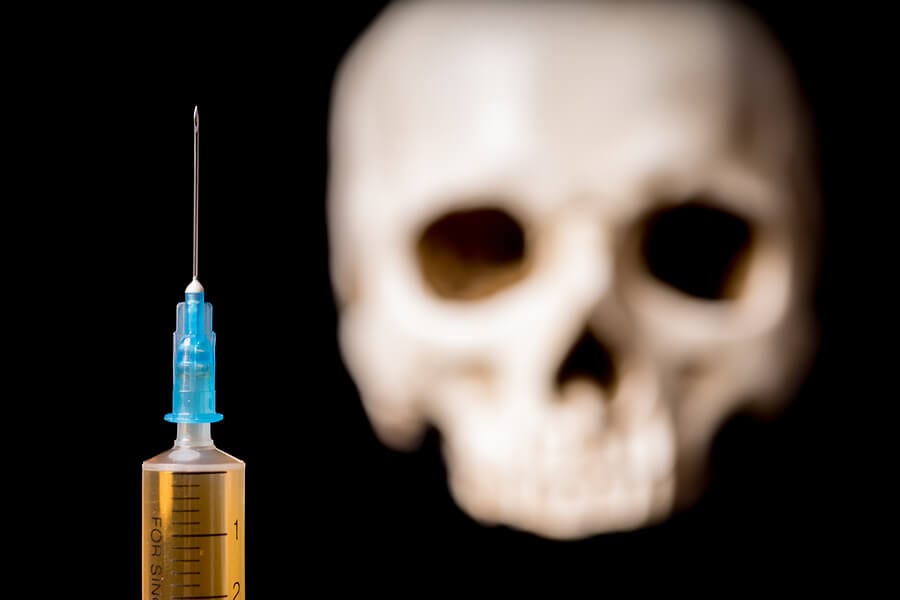
Desomorphine (dihydrodesoxymorphine) is an injectable derivative of the opiate codeine. On the street, the drug is commonly known as Krokodil or Crocodile. Krokodil is a drug that first appeared in Siberia in 2002, and has spread further into other areas of Russia since that time.
It is believed that the name “Krokodil” refers to the changes in the appearance of a user’s skin that results from regular use. Krokodil is a very caustic drug that can cause an addict’s skin to become green, scaly, and bumpy, like that of a crocodile. Also, if the user misses a vein and injects the drug into flesh, infected abscesses are very likely to form. Finally, it is common for addicts to develop gangrene and require amputations, and the flesh on some body parts may rot off completely, exposing bare bone.
Desomorphine is classified as a Schedule I substance in the U.S., indicating that it is considered to have a high potential for abuse and no accepted medicinal purpose. In its purest form, desomorphine is about 8-10 times more potent than morphine, and also has a more rapid onset of action (about 2-3 minutes) and shorter half-life. These factors account for its increased potential for addiction. Likewise, the short elimination half-life compels those who are dependent on Krokodil to inject more frequently to avoid withdrawals than those who are addicted to heroin and many other opioids.
Desomorphine: A Cheap Heroin Substitute
Reports indicate that Krokodil use has spread rapidly across parts of Russia, with perhaps hundreds of thousands of people having injected the drug in recent years. The drug has also continued to spread to surrounding countries like the Ukraine and Kazakhstan. Although use appears to be centered in the Soviet region, countries like Norway and Germany have also reported incidents of Krokodil use, as well.
Krokodil is produced from codeine and medications that contain codeine. In drug markets such as those in Russia where heroin is relatively difficult to obtain, people have turned to alternatives such as Krokodil. Krokodil is frequently used as a substitute for heroin, due to its low cost and increasing availability.
Krokodil is appealing to those seeking an intense high because it is cheap, relatively easy to make or obtain, and produces a high similar to that of heroin. Effects can last up to two hours and include euphoria, sedation, and potent pain relief.
Krokodil Manufacturing
Users have stated that krokodil can be made in as little as 45 minutes with codeine and minimal equipment. Similar to homemade methamphetamine, users often combine several toxic ingredients, such as hydrochloric acid, gasoline, and household cleaning products, with the codeine.
Effects of Desomorphine
Krokodil’s effects can be devastating and life-threatening. Injection of the drug can result in the following complications:
- Skin and soft tissue infections
- Thrombophlebitis (inflammation of veins)
- Skin ulcers
- Gangrene
- Necrosis (death of living tissue)
When the drug is administered intravenously, it can damage veins and result in localized infections, which may ultimately spread to other areas and lead to organ damage. If some parts of the body, such as the limbs are severely infected, doctors may need to amputate or perform surgery.
Because Krokodil is a homemade opiate, the conditions in which it is manufactured can also introduce a number of other health risks. Users making the drug often share equipment and needles for injection. The sharing of syringes increases a person’s risk of contracting HIV and the hepatitis C virus. And because Krokodil is a drug with a short-half life that is often administered repeatedly throughout the day, this can substantially increase the likelihood that use of non-sterile needles will occur.
Even short-term Krokodil use can result in severe health complications and fatalities. Death for chronic users is common within 2-3 years of the first dose, but even initial use can be fatal in some cases.

Why Is Desomorphine Called the “Zombie Drug”?
Krokodil has frequently been referred to as the “zombie drug” by the media. Many reports of desomorphine drug use by the press have shown affected individuals having gangrene or dead patches of skin (eschars) on their body, which may in many ways resemble what we think of as having the appearance of a zombie. Also, the skin of Krokodil users can become black, grey, or green, and scabby, scaly, and flaky.
Is Krokodil in the United States?
There have been a few sensational reports about the appearance of desomorphine in the U.S. based on a small number of suspected cases. At the time of this writing, however, neither the Drug Enforcement Administration nor the National Institute on Drug Abuse (NIDA), had confirmed any cases of Krokodil use in the country.
Treatment for Opioid Addiction
In the United States, the most serious opioid addictions are related to heroin, and it’s even more potent cousin, fentanyl. These drugs devastate lives and result in severe, life-threatening health complications, as well as social withdrawal and financial hardship.
Harmony Recovery Center offers intensive treatment for heroin addiction that includes evidence-based services vital to the recovery process, such as behavioral therapy, counseling, group support, medication-assisted therapy, and aftercare planning.
If you or someone you know is struggling with heroin addiction, please contact us immediately. We provide people with the tools and support they need to reclaim their lives and free themselves from the deadly grip of addiction indefinitely!
Related: China White Heroin